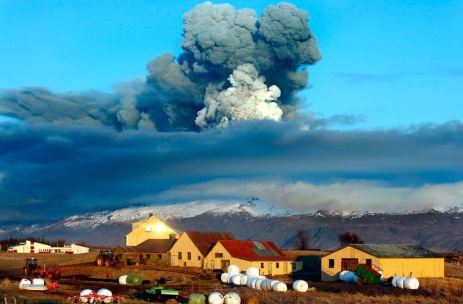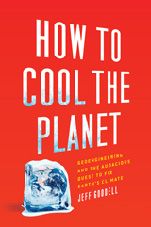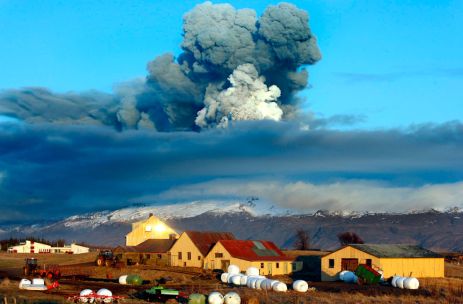 EyjafjallajokullPhoto courtesy Ludie Cochrane via FlickrIn America, we don’t care much about science. We care about sex and violence and money. That makes it hard to sustain a conversation about geoengineering, given that there is very little sex or money involved, and the only violence is likely to be brought on by future climate catastrophes.
EyjafjallajokullPhoto courtesy Ludie Cochrane via FlickrIn America, we don’t care much about science. We care about sex and violence and money. That makes it hard to sustain a conversation about geoengineering, given that there is very little sex or money involved, and the only violence is likely to be brought on by future climate catastrophes.
A good volcano, however, does remind people that there are larger forces in the world than Oprah Winfrey.
First, let me say that Eyjafjallajokull, the mountain which erupted in Iceland last week, is a pretty whimpy volcano. No rolling rivers of lava, very little sulfur dioxide injected into the stratosphere. The volcano was only notable, in fact, because the wind currents took the ash right over some of the busiest airports in the world, shutting down air traffic and marooning travelers in airport bars around the world.
Mt. Pinatubo, which erupted in the Phillipines in 1991 — now that was a volcano. Pinatubo injected 20 million tons of sulfur (in the form of sulfur dioxide) into the upper atmosphere and had a global impact climate (the sulfur particles act as tiny mirrors, reflecting sunlight away from the planet.) In the year after the eruption, the temperature of the earth dropped by a degree or so. Scientists had previously considered the idea of injecting particles into the stratosphere to cool the planet — in a sense, Mt. Pinatubo was the mother of all field tests for this idea. And it worked reasonably well.
Eyjafjallajokull is unlikely to have any such global impact. But perhaps because it exploded in the week leading up to Earth Day, it has inspired a lot of talk about the power and glory of Mother Nature. Who can look at fiery images of hell and brimstone erupting out of a mountain and not be impressed by Her Awesomeness?
The volcano also reminded us of the fragile technological web that weaves together modern life. I mean, this little smoker in Iceland nearly stalled the economy of the E.U. Who knew that a few pounds of ash could bring down an airliner — one of the crowning glories of western technology? A few months of continued eruptions, and you could imagine the U.K. turning into a scene right out of the Cormac McCarthy’s The Road.
 But for me, Eyjafjallajokull was metaphor for something else entirely: bad engineering. When I looked at images of all that billowing ash, I saw lots of energy being released for no “purpose” whatsoever. I saw gases and particles dumped into the atmosphere at too low an altitude to have any effect on cooling the planet — or even to be useful in the study of how particles can cool the planet. I saw a volcano erupting at an inconvenient place (too close to airline routes), and with not enough power to accomplish much useful or interesting beyond reminding us of the awe and wonder of nature. Well, what about nature with a purpose? What about good design?
But for me, Eyjafjallajokull was metaphor for something else entirely: bad engineering. When I looked at images of all that billowing ash, I saw lots of energy being released for no “purpose” whatsoever. I saw gases and particles dumped into the atmosphere at too low an altitude to have any effect on cooling the planet — or even to be useful in the study of how particles can cool the planet. I saw a volcano erupting at an inconvenient place (too close to airline routes), and with not enough power to accomplish much useful or interesting beyond reminding us of the awe and wonder of nature. Well, what about nature with a purpose? What about good design?
Ok, so that’s still a long way from sex, violence, and money. But perhaps this is one of the unintended consequences of thinking too long and too hard about geoengineering — you start to see the whole planet as a big construction project that can be tweaked and optimized and improved. You start seeing sublime events like the eruption of a volcano and you think: Can’t we humans build a better volcano than that?
—–
Editor’s note: This is the fourth in a series of posts from Jeff Goodell, author of How to Cool the Planet: Geoengineering and the Audacious Quest to Fix Earth’s Climate. Here’s his first, second, and third posts. And here’s an interview with Goodell about his book, and an earlier interview about Big Coal.


